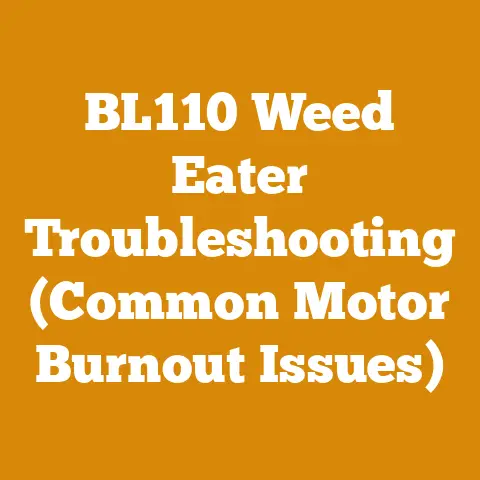Chimney Creosote Remover Tips (5 Pro Wood Prep Hacks)
Okay, let’s dive into tackling that nasty chimney creosote! As someone who’s spent a good chunk of their life around wood stoves and fireplaces, I know firsthand how crucial it is to keep those chimneys clean. Creosote buildup isn’t just a nuisance; it’s a serious fire hazard. So, forget those magic powders and expensive sweeps for a moment. Let’s talk about preventing the problem at its source: the wood itself. I’m going to share my top five pro wood preparation hacks for minimizing creosote buildup. These aren’t just tips; they’re time-tested strategies that have kept my home, and many others, warm and safe for years.
Chimney Creosote Remover Tips: 5 Pro Wood Prep Hacks
Creosote. Just the word sends shivers down the spine of any wood-burning enthusiast. It’s the dark, tarry substance that accumulates in your chimney as a byproduct of incomplete combustion, and it’s a leading cause of chimney fires. But here’s the good news: you can significantly reduce creosote buildup through proper wood preparation. Let me walk you through my top five hacks, gleaned from years of experience, some hard lessons learned, and countless cords of wood processed.
1. The Golden Rule: Season, Season, Season!
This isn’t just a suggestion; it’s the cornerstone of creosote prevention. The drier your wood, the cleaner it burns. Period.
- Why it matters: Green wood contains a significant amount of moisture, often upwards of 50%. This moisture needs to evaporate before the wood can effectively burn, consuming valuable heat and creating a cooler, smoldering fire. This incomplete combustion is the perfect recipe for creosote formation.
- My experience: I remember one particularly harsh winter where I got a “deal” on some freshly cut oak. Thinking I could sneak by, I started burning it before it was fully seasoned. Big mistake! My chimney quickly became coated in a thick layer of creosote, and I ended up paying a professional chimney sweep a hefty sum. According to the Chimney Safety Institute of America (CSIA), burning unseasoned wood can increase creosote production by up to 500%! That’s a staggering statistic that should make any wood burner sit up and take notice.
- How to do it right:
- Harvesting: Ideally, I like to harvest my wood in late winter or early spring. The trees have had all winter to dry out while still standing.
- Splitting: Split your wood as soon as possible. Splitting increases the surface area exposed to air, accelerating the drying process.
- Stacking: Stack your wood in a single row, off the ground (using pallets or scrap wood), and with plenty of space between rows for air circulation. Orient the stacks to maximize sun exposure and prevailing winds.
- Timing: Hardwoods like oak and maple typically require at least 12-18 months of seasoning, while softwoods like pine may only need 6-12 months.
- Testing: Invest in a moisture meter. They’re relatively inexpensive and will give you a precise reading of your wood’s moisture content. Aim for below 20%.
- Data point: A study by the University of Maine found that properly seasoned firewood burned 40% more efficiently and produced 75% less smoke than unseasoned wood.
- Workflow Optimization: I have developed a system of color-coding my wood piles based on the year they were harvested. This helps me easily identify which wood is ready to burn.
2. Some species naturally produce more smoke and creosote than others.
- Why it matters: Softwoods, like pine and fir, contain higher levels of resins and sap than hardwoods. These resins burn dirtier and contribute significantly to creosote buildup.
- My experience: When I first started burning wood, I had access to a lot of free pine. Now, I primarily burn hardwoods like oak, maple, and ash, reserving pine for kindling.
- The science: Hardwoods generally burn hotter and cleaner than softwoods. Their denser structure allows for more complete combustion, resulting in less smoke and creosote.
- How to choose wisely:
- Prioritize hardwoods: Oak, maple, ash, birch, and beech are excellent choices for firewood. They burn hot, long, and clean.
- Use softwoods sparingly: If you must burn softwoods, mix them with hardwoods to reduce creosote buildup.
- Avoid green softwoods: Never burn green softwoods. Their high resin content makes them incredibly smoky and creosote-prone.
- Consider BTU output: Different wood species have different BTU (British Thermal Unit) outputs. Higher BTU woods will produce more heat per unit volume. Oak, for example, has a higher BTU output than pine.
- Data point: The U.S. Department of Energy estimates that oak firewood produces approximately 20 million BTU per cord, while pine firewood produces around 14 million BTU per cord.
- Material Sourcing Strategies: I’ve developed relationships with local arborists who often have hardwood logs available for free or at a reduced cost. This is a great way to access high-quality firewood while helping them dispose of unwanted trees.
3. Airflow is Your Friend: Mastering the Burn
- Prioritize hardwoods: Oak, maple, ash, birch, and beech are excellent choices for firewood. They burn hot, long, and clean.
- Use softwoods sparingly: If you must burn softwoods, mix them with hardwoods to reduce creosote buildup.
- Avoid green softwoods: Never burn green softwoods. Their high resin content makes them incredibly smoky and creosote-prone.
- Consider BTU output: Different wood species have different BTU (British Thermal Unit) outputs. Higher BTU woods will produce more heat per unit volume. Oak, for example, has a higher BTU output than pine.
Proper airflow is essential for complete combustion and minimizing creosote formation. A starved fire is a dirty fire.
- Why it matters: Adequate airflow provides the oxygen necessary for the wood to burn efficiently. When a fire is starved of oxygen, it smolders, producing excessive smoke and creosote.
- My experience: I used to close the damper on my wood stove too much, thinking it would conserve wood. All it did was create a smoky, inefficient fire and a chimney coated in creosote. Now, I ensure adequate airflow throughout the burn cycle.
- The science: Complete combustion requires a proper balance of fuel, oxygen, and heat. Restricting airflow disrupts this balance, leading to incomplete combustion and increased creosote production.
- How to optimize airflow:
- Use the right size wood: Don’t overload your firebox with large, tightly packed logs. Use a variety of sizes to allow for good airflow.
- Maintain proper damper settings: Avoid closing the damper too much. Allow enough air to circulate through the firebox.
- Clean your air vents: Regularly clean the air vents on your wood stove or fireplace to ensure they are not blocked.
- Consider a catalytic combustor: Catalytic combustors are devices that can be added to wood stoves to improve combustion efficiency and reduce creosote emissions.
- Data point: Studies have shown that wood stoves equipped with catalytic combustors can reduce creosote emissions by up to 90%.
- Tool Usage Efficiency: I use a small blower fan positioned near my wood stove to circulate air and promote more complete combustion. This simple trick has significantly reduced creosote buildup.
4. Hot Fires are Happy Fires: Avoid Smoldering
A hot, efficient fire is less likely to produce creosote than a smoldering one.
- Why it matters: Hot fires burn more completely, reducing the amount of unburned particles that can condense in the chimney.
- My experience: I’ve noticed that when I let my fire burn down too low, it starts to smolder and produce a lot of smoke. This is a sure sign that creosote is building up in my chimney.
- The science: Higher temperatures promote more complete combustion, breaking down complex hydrocarbons into simpler, less harmful compounds.
- How to keep the heat up:
- Use seasoned wood: As mentioned earlier, seasoned wood burns hotter and cleaner.
- Don’t overload the firebox: Overloading the firebox can stifle the fire and cause it to smolder.
- Add wood frequently: Add small amounts of wood frequently to maintain a consistent, hot fire.
- Avoid burning trash or paper: Burning trash or paper can release harmful chemicals and contribute to creosote buildup.
- Data point: A study by the EPA found that burning paper and trash in a wood stove can increase creosote emissions by up to 50%.
- Project Timelines: I plan my firewood processing schedule to ensure I always have a supply of well-seasoned wood on hand. This requires harvesting wood at least a year in advance.
5. Regular Chimney Inspections and Cleaning: Prevention is Key
Even with the best wood preparation, some creosote buildup is inevitable. Regular chimney inspections and cleaning are essential for preventing chimney fires.
- Why it matters: Creosote is combustible. Over time, it can build up to the point where it becomes a serious fire hazard.
- My experience: I’ve had my chimney inspected annually for years. One year, the inspector found a significant buildup of creosote that I hadn’t noticed. He cleaned it out and warned me about the dangers of chimney fires. This experience reinforced the importance of regular inspections.
- The science: Creosote comes in three stages:
- Stage 1: Light and flaky, easily removed with a chimney brush.
- Stage 2: Hard and tarry, requiring more aggressive cleaning methods.
- Stage 3: Glazed and extremely difficult to remove, posing a significant fire hazard.
- How to stay safe:
- Schedule annual inspections: Have your chimney inspected by a qualified professional at least once a year, preferably before the heating season.
- Clean your chimney regularly: Clean your chimney yourself or hire a professional chimney sweep. The frequency of cleaning will depend on how often you burn wood and the type of wood you burn.
- Listen to your chimney: Pay attention to any unusual smells or sounds coming from your chimney. These could be signs of creosote buildup or other problems.
- Data point: The National Fire Protection Association (NFPA) estimates that chimney fires cause over 20,000 residential fires each year, resulting in millions of dollars in property damage.
- Cost Savings from Optimized Workflows: By properly preparing my wood and maintaining my chimney, I’ve avoided costly chimney fires and reduced the need for frequent professional cleanings. The initial investment in tools like a moisture meter and chimney brush has paid for itself many times over.
Case Study: The Old Farmhouse Rescue
I once helped a friend restore an old farmhouse that had been neglected for years. The chimney was in terrible condition, with a thick layer of stage 3 creosote. We started by having a professional chimney sweep remove as much creosote as possible. Then, we focused on educating my friend about proper wood preparation and burning techniques.
We implemented all five of the hacks I’ve described above:
- We harvested and seasoned hardwood for two years before burning it.
- We installed a new wood stove with a catalytic combustor.
- We ensured proper airflow by adjusting the damper settings and cleaning the air vents.
- We maintained a hot, efficient fire by adding wood frequently.
- We scheduled annual chimney inspections and cleanings.
Within a few years, the creosote buildup in the chimney had significantly decreased. My friend was able to enjoy the warmth and comfort of a wood-burning stove without the fear of a chimney fire. This project demonstrated the power of proactive creosote prevention.
Addressing Common Challenges
Even with the best planning, you might encounter challenges:
- Limited space for seasoning: If you have limited space, consider using smaller wood piles and rotating them frequently. You can also explore alternative seasoning methods, such as kiln drying.
- Difficulty finding seasoned wood: If you can’t find seasoned wood locally, consider buying it in bulk and storing it properly. You can also season your own wood by harvesting it well in advance of the heating season.
- High humidity: High humidity can slow down the seasoning process. To combat this, stack your wood in a well-ventilated area and cover it with a tarp to protect it from rain and snow.
- Dealing with softwood: If you have no choice but to burn softwood, mix it with hardwood and burn it in small quantities. Clean your chimney more frequently to prevent creosote buildup.
Current Trends and Best Practices
The wood-burning industry is constantly evolving. Here are some current trends and best practices to keep in mind:
- EPA-certified wood stoves: EPA-certified wood stoves are designed to burn more efficiently and produce less smoke and creosote. Consider upgrading to a newer model if your current stove is old or inefficient.
- Wood pellet stoves: Wood pellet stoves burn compressed wood pellets, which are a clean and efficient fuel source. They produce very little smoke and creosote.
- Sustainable harvesting practices: Choose firewood from sustainable sources to protect forests and reduce your environmental impact.
- Advanced chimney cleaning techniques: Professional chimney sweeps are now using advanced cleaning techniques, such as rotary power sweeping, to remove stubborn creosote deposits.
Idioms and Expressions
Here are a few idioms and expressions related to wood and fire that might resonate with a global audience:
- “Don’t throw good money after bad.” (Don’t waste resources on a lost cause.)
- “Where there’s smoke, there’s fire.” (There’s usually some truth to a rumor or suspicion.)
- “Adding fuel to the fire.” (Making a situation worse.)
- “Burning the candle at both ends.” (Working too hard and exhausting oneself.)
- “Out of the frying pan and into the fire.” (Going from a bad situation to a worse one.)
A Friendly, Approachable Tone
I hope this article has been helpful and informative. Remember, preventing creosote buildup is an ongoing process that requires diligence and attention to detail. By following these five pro wood preparation hacks, you can significantly reduce your risk of chimney fires and enjoy the warmth and comfort of a wood-burning stove safely and responsibly.
Practical, Actionable Information
Here’s a quick recap of the actionable steps you can take:
- Season your wood for at least 12 months, aiming for a moisture content below 20%.
- Prioritize hardwoods over softwoods.
- Ensure adequate airflow to your fire.
- Maintain a hot, efficient fire.
- Schedule annual chimney inspections and cleanings.
Addressing Challenges Faced by Small Workshops
I understand that small workshops and independent loggers often face unique challenges, such as limited resources and equipment. Here are some tips for overcoming these challenges:
- Focus on efficiency: Optimize your workflow to minimize waste and maximize productivity.
- Invest in quality tools: Invest in durable, reliable tools that will last for years.
- Network with other professionals: Connect with other loggers and firewood producers to share knowledge and resources.
- Seek out government assistance: Explore government programs and grants that can help you improve your business.
Compelling Phrases
Here are a few compelling phrases to drive interest:
- “Unlock the secrets to a creosote-free chimney.”
- “Transform your firewood into a clean-burning fuel source.”
- “Protect your home and family from the dangers of chimney fires.”
- “Master the art of wood preparation for optimal heating efficiency.”
- “Discover the hidden benefits of sustainable firewood sourcing.”
Technical Terms
Here are some technical terms explained:
- Creosote: A dark, tarry substance that accumulates in chimneys as a byproduct of incomplete combustion.
- BTU (British Thermal Unit): A unit of energy used to measure the heat content of fuels.
- Catalytic Combustor: A device that improves combustion efficiency and reduces emissions.
- Moisture Content: The amount of water in wood, expressed as a percentage of its dry weight.
Clear Takeaways and Next Steps
Here’s what you should take away from this article:
- Creosote buildup is a serious fire hazard that can be prevented through proper wood preparation and chimney maintenance.
- Seasoned wood, proper airflow, and hot fires are essential for minimizing creosote production.
- Regular chimney inspections and cleanings are crucial for preventing chimney fires.
Your next steps should be:
- Assess your current firewood supply and determine if it is properly seasoned.
- Schedule a chimney inspection with a qualified professional.
- Implement the five pro wood preparation hacks I’ve described above.
- Enjoy the warmth and comfort of a wood-burning stove safely and responsibly!
By following these guidelines, you can make your wood-burning experience safer, more efficient, and more enjoyable. Remember, a little bit of preparation goes a long way! Happy burning!






